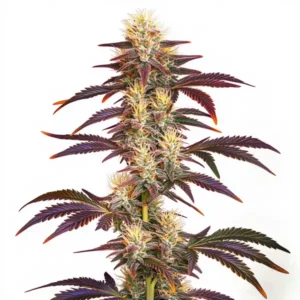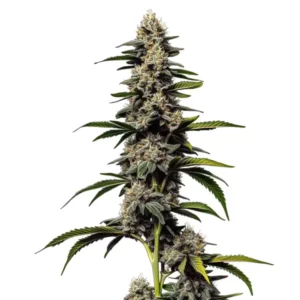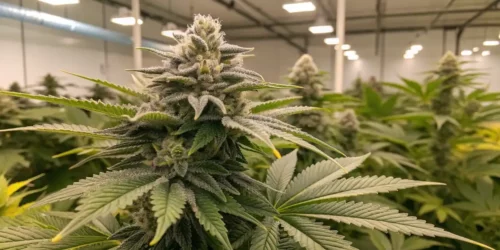Are your cannabis plants missing their vibrant green color, or are they excessively lush to a concerning degree? These signs may point to an imbalance, such as nitrogen deficiency. Cannabis plants suffering from nitrogen deficiency often display yellowing lower leaves and stunted growth, making early detection and correction essential for healthy development. This typical pattern is characteristic of cannabis plant nitrogen deficiency, which needs urgent intervention to avoid long-term damage.
Both of these conditions might indicate a nitrogen imbalance, an essential element for healthy cannabis growth. Nitrogen deficiency can result in stunted growth and pale leaves, whereas an excess can lead to overly vigorous growth and potential long-term health problems for your plants. In this guide, we’ll cover the signs of both nitrogen deficiency and toxicity, discuss their effects on cannabis, and offer practical strategies for achieving the ideal nitrogen balance. Our aim is to equip you with the knowledge to ensure your cannabis plants thrive at every growth stage.
Nitrogen Deficiency in Cannabis
Nitrogen is crucial for cannabis growth, playing a key role in chlorophyll production and photosynthesis. It is a major component of amino acids, the building blocks of proteins, which are vital for plant structure and function. Nitrogen is also integral to the production of enzymes and hormones that regulate growth and development. Both deficiency and excess nitrogen can significantly impact plant health. A deficiency in nitrogen can lead to stunted growth, yellowing leaves (chlorosis), and reduced yield. On the other hand, excessive nitrogen can cause dark green leaves, delayed flowering, and increased susceptibility to diseases. Managing nitrogen levels is essential for optimizing cannabis plant health and maximizing yield.
Yellow leaves are a primary indicator of nitrogen deficiency in cannabis. Additional symptoms to watch for include:
- Early stages: Leaves appear pale and may show slight yellowing.
- Advanced stages: Entire leaves turn yellow, including the veins, and may eventually brown or die off.
Monitoring these signs is crucial to ensure your cannabis plants receive adequate nitrogen and other essential nutrients for optimal growth and productivity.
Promos & Deals
Common Causes of Nitrogen Deficiency in Cannabis Cultivation
Nitrogen imbalances in cannabis cultivation can stem from factors like excessive organic matter or waterlogged soil. Overuse of organic matter can cause nitrogen to be consumed in the decomposition process, while waterlogged soil can convert usable nitrogen into gas, leading to deficiencies.
Hydroponic growers often encounter nitrogen deficiencies and toxicities due to improper fertilizer ratios in their water. In many cases, this imbalance is referred to as weed nitrogen deficiency, especially when symptoms appear quickly and dramatically. Another common cause is the water’s pH level. If the pH deviates from the optimal range of 5.5-6.2, nutrients in the hydroponic solution become unavailable for root absorption.

Identifying Nitrogen Deficiency in Cannabis
Deficiency Symptoms: Nitrogen deficiency typically appears first in the older, lower leaves, which change from green to pale yellow or lime as nitrogen is moved to new growth. As the deficiency worsens, these leaves may turn brown, become crispy, and eventually fall off. The overall plant growth slows, resulting in sparse and thin foliage. In flowering plants, nitrogen deficiency can lead to smaller buds and reduced yields.
Toxicity Symptoms: Excessive nitrogen results in leaves that are a lush, dark green, sometimes appearing almost black. Affected leaves may develop a claw-like curl and look glossy or overly wet. Over time, nitrogen toxicity can impair root development and delay flowering, negatively impacting the yield and quality of the buds.
Comparison with Other Nutrient Deficiencies
Nitrogen deficiency in cannabis uniquely affects older leaves first, unlike potassium, phosphorus, magnesium, calcium, iron, copper, and zinc deficiencies. These other deficiencies often present with brown spots or leaf curling, which are not typical symptoms of nitrogen deficiency.
How to Fix: Nitrogen Deficiencies
Effective management of nitrogen deficiency is crucial to ensure healthy cannabis plant growth. This involves adjusting soil conditions, considering both organic and chemical fertilizers, and implementing preventive actions to maintain optimal nitrogen levels throughout various growth stages.
Adjusting Soil and Root pH Levels
To resolve nitrogen deficiency in cannabis, it is essential to monitor and adjust the pH of both the soil and the root zone. Otherwise, a nitrogen deficiency weed plant may fail to absorb key nutrients and exhibit severe growth limitations. Cannabis plants thrive in a soil pH range of 6.0 to 7.0, which facilitates proper nitrogen uptake. If the pH is too low (acidic), adding lime can help increase it. Conversely, if the soil is too alkaline, sulfur compounds may be needed to reduce the pH.
Organic and Chemical Fertilizers
Addressing nitrogen deficiency in cannabis requires the correct fertilizers. Organic options such as blood meal, fish meal, manure, and compost release nitrogen slowly, improving soil health over time.
Another excellent organic solution is worm castings. Worm castings are a nutrient-rich amendment that supplies nitrogen and other vital nutrients, enhancing soil fertility and promoting vigorous cannabis growth. Compost is another valuable organic option that helps mitigate nitrogen deficiency by enriching the soil with decomposed organic matter.
For a quicker fix, chemical fertilizers like ammonium nitrate or calcium nitrate can be used. Pre-mixed nutrient solutions specifically designed for cannabis also provide balanced nourishment, including essential nitrogen.
Synthetic fertilizers offer a quick and efficient way to correct nitrogen deficiency in cannabis. Available in various forms, such as granules, liquids, and powders, these fertilizers provide an immediate source of nitrogen that can be applied directly to the soil or as a foliar spray. However, caution is needed to avoid over-fertilization, which can cause nutrient imbalances and harm the plants.
Alternative Nutrient Sources
Utilizing nitrogen-fixing bacteria is a natural method to enhance nitrogen availability for cannabis plants. These microorganisms, including species like Azospirillum brasilense found in products such as Azos by Xtreme Gardening, convert atmospheric nitrogen into a form usable by plants. Other beneficial nitrogen-fixing bacteria include Rhizobium and cyanobacteria, which can be added to soil as inoculants to improve fertility and promote robust plant growth.

Techniques to Prevent Nitrogen Deficiency in Cannabis
Proper Watering and Drainage
Over-watering and inadequate drainage are significant factors contributing to nitrogen deficiency in cannabis plants. Frequent watering can lead to nitrogen leaching from the soil, rendering it inaccessible to the plants. To mitigate this, ensure proper drainage to maintain optimal nutrient availability. Water your cannabis plants deeply but allow the soil to dry out between watering sessions. This practice helps maintain the soil’s nutrient balance and supports healthy plant growth.
Reduce Nitrogen Deficiency in Cannabis
Pests and diseases can stress cannabis plants, leading to nitrogen deficiency. To minimize these threats, maintain a clean garden free from debris and weeds, which can harbor pests. Implement natural pest control methods, such as companion planting and row covers, to protect your cannabis plants from damage. By reducing pest and disease pressure, you can help ensure that your plants have the nitrogen they need to thrive.
FAQs
What are the early signs of nitrogen deficiency in cannabis plants?
Early signs of nitrogen deficiency in cannabis include pale green or yellowing lower leaves, slowed growth, and reduced foliage density. As nitrogen deficiency cannabis symptoms progress, leaves may turn brown and crispy before falling off, and the plant’s overall vigor and yield can decline significantly.
How can I fix nitrogen deficiency in cannabis?
To correct nitrogen deficiency in cannabis, monitor and adjust soil pH to the optimal range of 6.0–7.0. Apply organic fertilizers like worm castings or compost for long-term improvement, or use chemical options such as ammonium nitrate for quick results. Maintaining proper watering and nutrient balance is also essential.
What causes nitrogen deficiency in cannabis cultivation?
Nitrogen deficiency in cannabis is often caused by poor soil conditions, overwatering, or incorrect pH levels that hinder nutrient uptake. In hydroponic systems, improper fertilizer ratios and water pH outside the 5.5–6.2 range are common culprits. Organic matter decomposition and pest stress can also contribute to deficiencies.
















